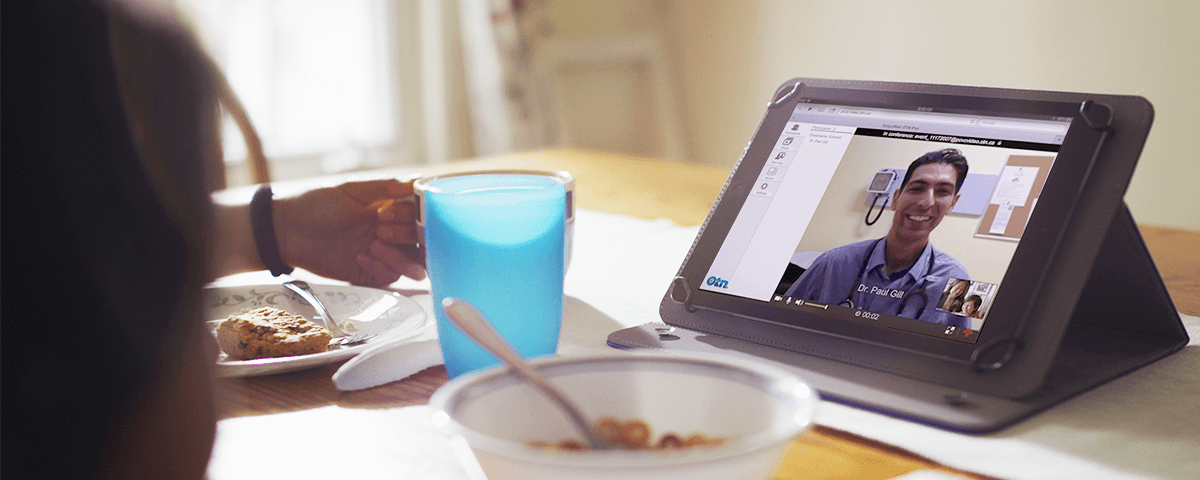Lead Organization: Kingston Health Sciences Centre (KHSC)
Program Name: Video Visits for Stroke Follow Up
Area of Care: Neurology
Healthcare Partners: Department of Medicine, Queen’s University, KHSC Neurologists, Stroke Network of Southeastern Ontario, Canada Health Infoway, Ontario Telemedicine Network
Vendor: OTN eVisit
minutes average appointment duration, compared to 80 minutes in person (travel time included).

Objectives
- Provide timely, convenient access to health care by way of video for people living with conditions such as stroke that result in frailty, loss of independence, restrictions in driving and mobility, and physical and cognitive decline
- Enhance access to care in Southeastern Ontario, where access is further complicated by rurality and the long travel distances to visit physician clinics
Model
As part of a provincial government-funded eVisit to the Home pilot, specialists and primary care providers deliver specialty care connect with patients by secure video to their home. Neurologists at the KHSC stroke prevention clinic launched an initiative as part of this broader pilot to leverage secure video through OTN for follow-up encounters with patients regularly seen for follow up in the stroke clinic.
Admin staff share the necessary information with patients on how to connect by video and schedule the video visit. Patients click an email link to connect at the appointed time. Providers either integrate video into their existing schedule or set aside dedicated time for video appointments.
The model provides:
- A convenient and secure way to do follow-up visits and review test results and treatment response with patients
- Utility for connecting for first-time visits and for mental health care delivery, cognitive behaviour therapy, and counselling sessions
Technology Type: OTN’s videoconferencing platform, available through the OTNhub (available with OTN membership), leverages a simple ‘OTNinvite’ interface providers to invite patients to connect for a video visit through OTN’s secure platform.
Outcomes
An integrated evaluation of the six-month pilot tested the impact of the program on clinic workflow and patient satisfaction (published, see below). Patient satisfaction (n=75) was evaluated by telephone interviews, using a brief questionnaire. The program was well received by patients, deemed to be safe by physicians, and avoided unnecessary patient travel and expense. The video visit took an average of 10 minutes to deliver with a high degree of patient satisfaction versus 80 minutes of patient time for an in-person visit, including travel time. Patient satisfaction was very high and 33% of patients indicated the video visit was better than an in-person visit. Travel distance avoided by the patients was 30.1 km, with estimated total out-of-pocket cost savings for patients per eVisit $52.83. There was approximately $25,000 of cost savings to the health care systems from the pilot study involving 75 patients. The projected cost savings are much higher if this is scaled up. Department of Medicine faculty have applied for external funding as part of their ongoing research into various aspects of eVisits like clinical outcomes, patient experience, and health economics.
Source: Appireddy R, Khan S, Leaver C, Martin C, Jin A, Durafourt BA, Archer SL. Home Virtual Visits for Outpatient Follow-Up Stroke Care: Cross-Sectional Study. J Med Internet Res 2019;21(10):e13734 URL: https://www.jmir.org/2019/10/e13734 DOI: 10.2196/13734 PMID: 31593536
%
indicated the video visit was better than in-person
average patient travel (km) avoided
patient cost-savings per eVisit ( $ est.)
Change Required to Support the Model
The Department of Medicine provided the seed funding to jumpstart the creation of this pilot program. This builds on the Department’s commitment to e-health in all 14 of its Divisions.
Standard change management approaches support the success of this initiative, including, for organization-wide implementation, leadership buy-in and support. For individual practitioners, there were some changes to workflow (e.g. dedicated time to manage the virtual component) and the involvement of administrative staff to support scheduling.
Three neurologists support this model. The model has been validated as appropriate for “low demand clinical activity”; while video does not replace the initial in-person visit, it has successfully accommodated 30% of follow-up visits in the Stroke Prevention Clinic. Based on the findings, the model is now in use in the hospital’s epilepsy clinic and expansion to other divisions has been prioritized within the Department of Medicine.
Adoption Rate
- 75 video visits from August 2018 to January 2019
- 150 video visits as of September 2019
To learn more about these solutions
or for any questions, please contact us.
Disclaimer
OTN is an independent, not-for-profit organization funded by the Government of Ontario. The views expressed here are the views of OTN, or the respective authors if a third-party, and do not necessarily reflect those of the Province. For further information, please note the Proprietary Rights detailed within the OTN Terms of Service available at https://otn.stagingotn.ca/terms-conditions/
